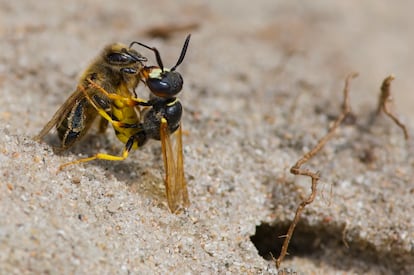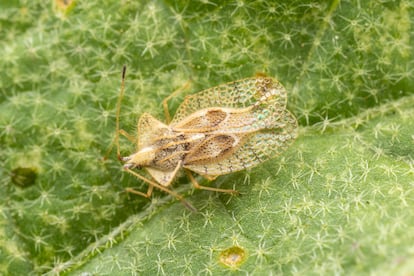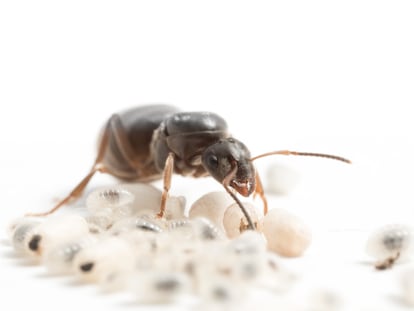Intestinal fluids for baby cockroaches and mothers devoured by their young: Childcare among insects
Bugs’ parental instincts run the gamut and in many cases, have evolved out of a necessity to defend against a variety of threats

If at some point you see a cockroach with a bundle stuck to its abdomen, rest assured that it is a female protecting its young, as its species has done for millennia. Many of these insects create special capsules called oothecas, where they carry their eggs until their nymphs are born and become independent. A study published in 2018 found ootheca fossils in northeast China that were more than 115 million years old.
Parental care among insects is not just ancient, it’s also incredibly ample and diverse. It has often evolved with the goal of protecting against different threats and takes on all imaginable forms. In this article, we’ll get to know some of its most extreme examples.
As the ectothermic animals they are, insects can’t generate their own heat, and this is one of the primary challenges they face when it comes to surviving in adverse climates. Given that in many cases climate change is leading to more extreme meteorological phenomena, it’s of utmost importance that we understand how parental care can be a buffering mechanism for variations in ambient temperature.
One species of burying beetle (Nicrophorus vespilloides), prevalent in the Northern hemisphere, breeds on the carcasses of small vertebrates. When their larvae hatch, they feed on the carcass, an act of continuing parental care. A team of researchers discovered that without the care of the females, the larvae of this beetle manage to survive at a temperature of 68ºF — but not as low as 59ºF, as they would under the supervision of their parents. Scientists believe that this may be due to competition that takes place at this temperature between the larvae and microorganisms. That is to say, when mothers are present, they can control the microorganism population, thus allowing their offspring to live at lower temperatures.
The burying beetle doesn’t just help when temperatures are low. It also feeds its larvae by regurgitating carrion when its young cannot yet eat on their own. When the carcass is too small to feed all the larvae, their parents eat some of them.
The former of these care methods is reminiscent of how birds incubate their chicks and bring food to them. But there are other insects that are more mammalian in style. The cockroach Cryptocercus punctulatus feeds on wood. When its nymphs are too young to process this feed for themselves, they drink from their parents’ gut fluids, resembling suckling pigs. This allows the young to acquire the intestinal flagella necessary for cellulose digestion.
The beewolf (Philanthus Triangulum) is a species of wasp that got its name for a good reason: females hunt bees, paralyzing them and bringing them home to feed their young. They are often found in warm and humid environments, which have a high risk of food spoilage. To preserve their feed, the mother applies chemical secretions that reduce fungal growth.
Sometimes, merely providing food is not enough, which is why cuckoo flies (Miltogramminae) are also pointedly named. Like the cuckoo, they deposit their young in other animals’ nests — in this case, wasp dens, killing the immature wasps and allowing their own young to eat their food supplies. To avoid this distressing fate, wasp mothers make regular visits to their nests not only to provide food, but also to clean them of fly larvae.
But perhaps the most extreme case of food supply is that of the humpback earwig (Anechura harmandi). The nymphs kill and eat their mother before leaving the nest. These mothers do not attempt to escape the cannibalism, nor do they produce a second brood when isolated from their nymphs. (Now, that’s a committed parent.)
Among some insects, child-raising duties can be so laborious that they require the participation of both parents. The aforementioned burying beetle is monogamous and moms as well as dads help with caring for young. She tends to be in charge of feeding and he, security, although both defend their offspring by attacking intruders in tandem. Those predators can even be other burying beetles, since in this species, infanticide is common.
Another well-known case of biparental care is that of the Australian rhinoceros cockroach (Macropanethia rhinoceros), the biggest cockroach in the world. Adults mate in the burrow and feed their young with leaves and droppings they gather as a team. The animal is so curious that in Australia, it is sold as a pet, and there are guides dedicated to teaching individuals about their proper care.

Since we’ve gotten this far, we would be amiss not to mention the famous communal broods of bees, ants and termites. In the case of yet another giant Australian bug, the termite Mastotermes darwiniensis, the king and queen produce excretions with which they feed their worker offspring so that they stay in the nest and help with household chores.
Lesser known is the behavior of the bedbug Elasmucha grisea. They are often attacked by predators like ants, who devour their eggs. Since there is strength in numbers, several females will gather to be able to defend themselves more effectively.
Other female bedbugs (Gargaphia solani) lay their eggs in the nest of a relative and leave. This does not seem to be a case of parasitism, since it ultimately benefits all involved. On one hand, the bedbug that deposits the eggs does not have to invest energy in caring for them. On the other, one study showed that the brood of the bug left with the extra eggs is more likely to survive should a predator make an appearance, because the intruder will eat a smaller percentage of the augmented number of ovum.
Finally, some insects leave the child-rearing to another species entirely. Such is the case of treehoppers (Membracidae, not to be confused with aphids, which are Aphididae), small insects that suck plant sap and transform it into honey. Females lay their eggs on leaves and take care of their young when they hatch, but in the presence of ants, they abandon their offspring and leave to produce new litters. One study showed that the ants end up protecting this young from predators and, in return, fed on their honey when they matured.
Due to this vast abundance and diversity, insects provide an ideal model for researching the evolution of parental care. It’s curious how little we take them into account when we think of responsible moms and dads.
Sign up for our weekly newsletter to get more English-language news coverage from EL PAÍS USA Edition
Tu suscripción se está usando en otro dispositivo
¿Quieres añadir otro usuario a tu suscripción?
Si continúas leyendo en este dispositivo, no se podrá leer en el otro.
FlechaTu suscripción se está usando en otro dispositivo y solo puedes acceder a EL PAÍS desde un dispositivo a la vez.
Si quieres compartir tu cuenta, cambia tu suscripción a la modalidad Premium, así podrás añadir otro usuario. Cada uno accederá con su propia cuenta de email, lo que os permitirá personalizar vuestra experiencia en EL PAÍS.
¿Tienes una suscripción de empresa? Accede aquí para contratar más cuentas.
En el caso de no saber quién está usando tu cuenta, te recomendamos cambiar tu contraseña aquí.
Si decides continuar compartiendo tu cuenta, este mensaje se mostrará en tu dispositivo y en el de la otra persona que está usando tu cuenta de forma indefinida, afectando a tu experiencia de lectura. Puedes consultar aquí los términos y condiciones de la suscripción digital.
More information
Archived In
Últimas noticias
Most viewed
- Reinhard Genzel, Nobel laureate in physics: ‘One-minute videos will never give you the truth’
- Oona Chaplin: ‘I told James Cameron that I was living in a treehouse and starting a permaculture project with a friend’
- Pablo Escobar’s hippos: A serious environmental problem, 40 years on
- Why we lost the habit of sleeping in two segments and how that changed our sense of time
- Chevy Chase, the beloved comedian who was a monster off camera: ‘Not everyone hated him, just the people who’ve worked with him’











































